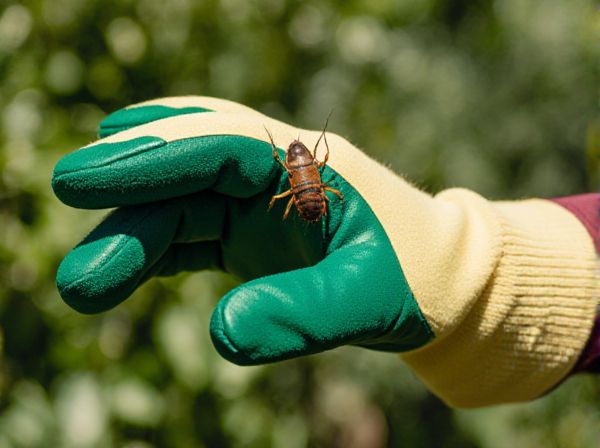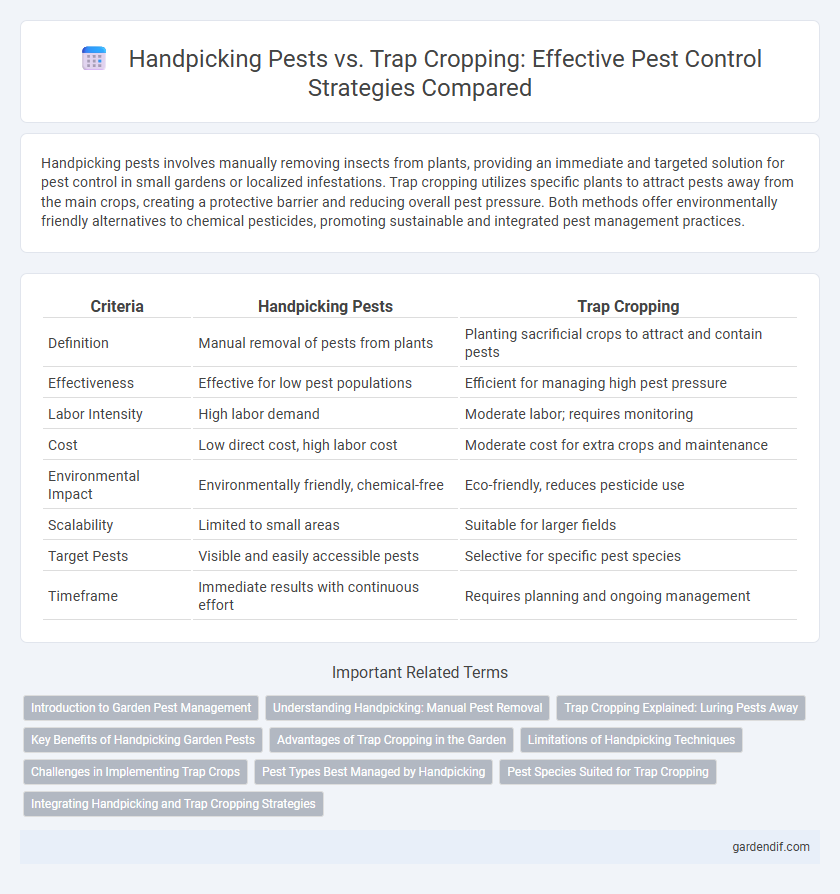
Handpicking pests vs trap cropping Illustration
Handpicking pests involves manually removing insects from plants, providing an immediate and targeted solution for pest control in small gardens or localized infestations. Trap cropping utilizes specific plants to attract pests away from the main crops, creating a protective barrier and reducing overall pest pressure. Both methods offer environmentally friendly alternatives to chemical pesticides, promoting sustainable and integrated pest management practices.
Table of Comparison
| Criteria | Handpicking Pests | Trap Cropping |
|---|---|---|
| Definition | Manual removal of pests from plants | Planting sacrificial crops to attract and contain pests |
| Effectiveness | Effective for low pest populations | Efficient for managing high pest pressure |
| Labor Intensity | High labor demand | Moderate labor; requires monitoring |
| Cost | Low direct cost, high labor cost | Moderate cost for extra crops and maintenance |
| Environmental Impact | Environmentally friendly, chemical-free | Eco-friendly, reduces pesticide use |
| Scalability | Limited to small areas | Suitable for larger fields |
| Target Pests | Visible and easily accessible pests | Selective for specific pest species |
| Timeframe | Immediate results with continuous effort | Requires planning and ongoing management |
Introduction to Garden Pest Management
Handpicking pests offers a direct and immediate method of garden pest management by physically removing insects, such as caterpillars and beetles, from plants, minimizing chemical use and environmental impact. Trap cropping involves planting specific plants like mustard or radishes to attract pests away from the main crops, effectively reducing pest populations and protecting valuable plants through strategic crop placement. Both techniques provide sustainable pest control options that enhance integrated pest management by targeting pests with minimal harm to beneficial insects and the ecosystem.
Understanding Handpicking: Manual Pest Removal
Handpicking pests involves physically removing insects, larvae, or eggs from plants, providing an immediate and chemical-free pest control method. This manual pest removal technique is highly effective for managing small infestations and minimizing damage to crops while preserving beneficial insect populations. Frequent inspection and careful removal maximize the success of handpicking as a sustainable pest management strategy.
Trap Cropping Explained: Luring Pests Away
Trap cropping involves planting a sacrificial crop that attracts pests away from the main crop, effectively reducing pest damage and minimizing pesticide use. This method targets specific pests by exploiting their feeding preferences, creating a controlled environment where they can be managed more easily. Research shows trap cropping can decrease pest populations by up to 70%, improving overall crop health and yield sustainability.
Key Benefits of Handpicking Garden Pests
Handpicking garden pests provides precise control by directly removing harmful insects like caterpillars, beetles, and aphids without affecting beneficial species. This method reduces reliance on chemical pesticides, promoting an eco-friendly and organic garden environment. Regular manual pest removal also minimizes plant damage and supports healthier crop growth.
Advantages of Trap Cropping in the Garden
Trap cropping effectively diverts pests from main plants, reducing damage and minimizing the need for chemical interventions. This method supports natural pest management by attracting pests to specific sacrificial plants, enhancing biodiversity and promoting a healthier garden ecosystem. Trap cropping also reduces labor intensity compared to handpicking, making it a practical and sustainable pest control strategy for gardeners.
Limitations of Handpicking Techniques
Handpicking pests is labor-intensive and impractical for large-scale farming due to the time and effort required to inspect each plant individually. This method is ineffective against small or hidden pests that are difficult to detect, such as aphids or spider mites. Trap cropping offers a more scalable solution by attracting pests to specific plants, but handpicking lacks the efficiency and coverage needed for comprehensive pest management in extensive fields.
Challenges in Implementing Trap Crops
Implementing trap crops faces challenges such as selecting appropriate plant species that effectively attract target pests without compromising main crop yield. Spatial arrangement and timing require precise management to ensure trap crops lure pests away without serving as a pest reservoir. Economic costs and increased labor demands can also hinder widespread adoption of trap cropping as a pest control strategy.
Pest Types Best Managed by Handpicking
Handpicking effectively controls pests like caterpillars, beetles, and slugs that are visible and slow-moving on plants. This method is especially useful for managing pests such as Colorado potato beetles, tomato hornworms, and Japanese beetles, which can damage crops through direct feeding. Handpicking minimizes chemical use, reducing harm to beneficial insects and promoting sustainable pest management in gardens and small-scale farming.
Pest Species Suited for Trap Cropping
Trap cropping effectively controls pest species such as aphids, flea beetles, and cabbage worms by attracting them away from main crops. Certain pest species, including stink bugs and leaf beetles, show strong preferences for trap crops like mustard or sorghum, making this method highly targeted and efficient. Understanding pest behavior and host plant specificity enhances the success of trap cropping in integrated pest management strategies.
Integrating Handpicking and Trap Cropping Strategies
Integrating handpicking and trap cropping enhances pest management by combining manual removal of pests with the strategic planting of trap crops that attract pests away from main crops. This dual approach reduces pest populations effectively, minimizes pesticide use, and promotes ecological balance within agricultural systems. Employing both methods optimizes pest control by targeting pests at different stages and locations, resulting in sustainable crop protection.
Handpicking pests vs trap cropping Infographic

 gardendif.com
gardendif.com